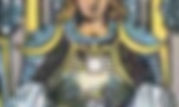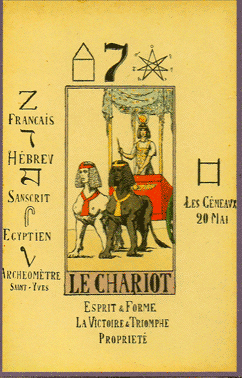Tarot Deep Dive - The Chariot
- Dustin
- May 22, 2021
- 5 min read
Updated: Aug 14, 2021
In this series we are going to dive into the history of the imagery found in the tarot, the meaning of the card and how it changed over time, and the symbols present within what is arguably the most well known tarot deck of today - the Rider-Waite (Smith) Tarot Deck. So grab your favorite RWS deck, a cup of tea or coffee, and join me live on Sunday mornings over on YouTube as we Deep Dive into each one of the 21 Major Arcana cards continuing with the legendary Chariot.
The Chariot of War, Chariot of Osiris, Victoria, Il Carro, Lord of the Triumph of Light
Often times when people think of a Chariot their imaginations instantly whisk them away to worlds of myth and legend like Egypt, Rome, and Greece. The famed god Apollo pulls the sun through sky daily with his magical chariot. The chariot as an object, and piece of technology radically transformed and shaped the ancient world and the landscape of warfare. For this exact reason the idea of the chariot has enraptured human civilizations for ages, and is exactly why it became a major trope in literature and art.

In ancient times the chariot was the luxury car of the day. Only the most wealthy and prestigious warriors, often nobility or royalty, could afford to field these in battle. The chariot, and charioteer, rapidly became one of the most feared forces on the ancient battlefield due to it's superior maneuverability and speed. The driver able to focus on navigating the field of battle, and the warrior or archer sat beside him became a fearsome pair that could decimate entire swaths of enemy forces. They really were the tanks of their day and age. Originating in Mesopotamia in about 3000 BC the chariot evolved from a simple ox pulled vehicle to the highly decorated, and even sometimes encased in metals like bronze and gold, racing vehicles popularized in Greece.
The historical significance and legendary popularity of this vehicle is likely why it landed a spot in the trump suite of the classic tarot decks, lest we forget; were designed for nobility to play a bridge-like game with. As the tarot evolved and took on more esoteric meanings through history this card not only drew on its historical iconography, and symbolism, but layered new meaning onto the card that we will explore below.
Visual Evolution
Evolution of Meaning
De Mellet (1781): Chariot of War. Crimes of the Iron Age.
Levi (1855): The Hebrew letter Zayin, the Cubic Chariot. Weapon, sword, cherubic sword of fire, the sacred septenary, triumph, royalty, priesthood.
Mathers (1888): The Chariot. Triumph, victory, overcoming obstacles.
Golden Dawn (1896): Child of the Power of the Waters, Lord of the Triumph of Light. The Chariot. Triumph, victory, health, success, though sometimes not enduring.
Waite (1910): The Chariot. Providence, war, triumph, presumption, vengeance.
Crowley (1944): The Ophiuchus wear an amber-colored armor which is suitable for the symbol. The mask of the helmet was pulled down so no one could see his face. For the same reason, none of his body parts was revealed. He sat still on the chariot instead of directing it because the entire operating system was in perfect balance. His only role is to keep the Holy Grail.
The Chariot concludes the first of the the three septenary, or division of seven, of the Major Arcana. Representing the victory of the Fool in his journey and his achievement of completing his first step on his path. Another title for the card Triumph for with the trumps or 'Trionfi' are named. The initial meaning of this card started out as a simple card of victory or travel and evolved into the more complex and modern meaning of control over opposing forces as esoteric symbols were added such as the pair of sphinx we see in the Waite-Smith deck. It is also interesting to note how the cards meaning took on darker tones through the course of history shifting from the classical ideal of victorious war to things like vengeance. However, the design and depiction of this card stayed true to the ideal of that historical Chariot for much of Tarot history, really only being layered with additional esoteric symbols as time went on. Unlike some of the other Major Arcana cards we have explored thus far, the Chariot seems to have only deepened in meaning over the course of history.
The Symbols
The Sphinxes

Representing duality, positive and negative and, at times, opposing forces the two Sphinxes are often the first symbol people are intrigued by. Sphinxes have a long history of representing mysteries. Made famous by the the famous myth of Oedipus and the Riddle of the Sphinx: What goes on four feet in the morning, two feet at noon, and three feet in the evening?
The Winged Disc

The winged sun is a symbol associated with divinity, royalty and power in the Ancient Near East (Egypt, Mesopotamia, Anatolia, and Persia).
Yoni & Lingam

What appears to be a Yoni & Lingam, traditional Indian representations of the male and female, represent the unity of opposites, much in the same way the sphinxes do.
Canopy of Stars & Laurel Crown of Stars

The Laurel and Crown of stars under the star canopy represents a mastery and victory over the temporal plane. The 8 pointed star represents his connection to the celestial world and the divine. Mastery over the cardinal and inter-cardinal directions. The number eight frequently represents beginnings, resurrection, salvation , and super-abundance in Judeo-Christian traditions or the traditional eight divisions of the wheel of the year in pagan traditions.
Moon Epaulettes

Waite describes these shoulders as Urim and Thummim. Mentioned in the Books of Samuel they are worn by priests to arbitrate with God on behalf of mankind.
Apron

Adorned with many different occult symbols, most notably geomantic ones that the Golden Dawn adopted from Agrippa, are thought to be an aspect of conjunction, or the coming together of things, another reference to a union.
Scepter

The wand or scepter, much like we see in the Emperor, symbolizes power. The scepter represents the sovereign's temporal power and is associated with good governance. Its worth noting that the charioteer holds no reins, just this scepter symbolizing his control through pure will of mind.
As always be sure to check out our live discussion on this very topic over on YouTube:
References
Butler, B. Dictionary of the Tarot. New York: Schocken Books, 1986.
Chang, T. Susan. Tarot Correspondences: Ancient Secrets for Everyday Readers. Llewellyn Pulbications, 2018.
Crowley, Aleister (aleister Crowley). Book of Thoth - (Egyptian Tarot). Red Wheel/Weiser, 2017.
Dean, Liz. The Ultimate Guide to Tarot: a Beginners Guide to the Cards, Spreads, and Revealing the Mystery of the Tarot. Fair Winds Press, 2015.
Fiebig, Johannes, and Evelin Burger. The Ultimate Guide to the Rider Waite Tarot. Llewellyn, 2013.
Katz, Marcus. Secrets of the Waite-Smith Tarot: the True Story of the Worlds Most Popular Tarot: with Previously Unseen Photography & Text from Waite & Smith. Llewellyn Publications, 2015.
Waite, A. E. Pictorial Key to the Tarot. Dover Publications Inc, 2005.
Wen, Benebell. Holistic Tarot. North Atlantic Books, 2015.
Images Sourced From: https://en.wikipedia.org/wiki/Wikipedia:Public_domain_image_resources












